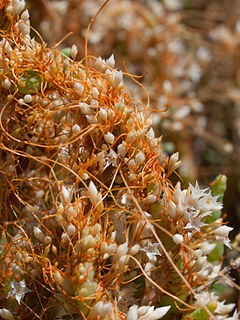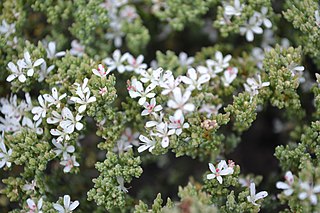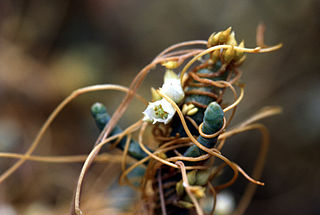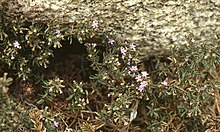In chemistry, an alkali is a basic, ionic salt of an alkali metal or an alkaline earth metal. An alkali can also be defined as a base that dissolves in water. A solution of a soluble base has a pH greater than 7.0. The adjective alkaline is commonly, and alkalescent less often, used in English as a synonym for basic, especially for bases soluble in water. This broad use of the term is likely to have come about because alkalis were the first bases known to obey the Arrhenius definition of a base, and they are still among the most common bases.

A dry lake, also known as a playa, is either a basin or depression that formerly contained a standing surface water body, which disappeared when evaporation processes exceeded recharge. If the floor of a dry lake is covered by deposits of alkaline compounds, it is known as an alkali flat. If covered with salt, it is known as a salt flat.

The Salinas Valley is one of the major valleys and most productive agricultural regions in California. It is located west of the San Joaquin Valley and south of San Francisco Bay and the Santa Clara Valley.

Salsola soda, more commonly known in English as opposite-leaved saltwort, oppositeleaf Russian thistle, or barilla plant, is a small, annual, succulent shrub that is native to the Mediterranean Basin. It is a halophyte that typically grows in coastal regions and can be irrigated with salt water.
California's coastal salt marsh is a wetland plant community that occurs sporadically along the Pacific Coast from Humboldt Bay to San Diego. This salt marsh type is found in bays, harbors, inlets, and other protected areas subject to tidal flooding.

The Seal Beach National Wildlife Refuge is a wildlife refuge encompassing 965 acres (3.91 km2) located in the California coastal community of Seal Beach. Although it is located in Orange County it is included as part of the San Diego National Wildlife Refuge Complex. It was established in 1972.

Frankenia portulacifolia, also called Saint Helena tea or tea plant, is a species of salt-tolerant plant in the Frankeniaceae family. It is endemic to the islands of Saint Helena, Ascension and Tristan da Cunha. Its natural habitats are inhospitable, dry and rocky areas and rocky shores, often on weathered volcanic ash. As its total population has been estimated at only around 3,500 individuals, it is currently classified as Critically Endangered by the IUCN.

Puccinellia is a genus of plants in the grass family, known as alkali grass or salt grass.

Heliotropium curassavicum, commonly called salt heliotrope, a species of flowering plant in the borage family (Boraginaceae). It is native to much of the Americas, from Canada to Argentina, including the West Indies and Hawaii. It can be found as an introduced, and sometimes invasive, species in Africa, Asia, Australia, and Europe. It thrives in salty soils, such as beach sand, alkali flats, and salt marshes. It is often found in disturbed coastal sites.

Isocoma acradenia is a North American species of flowering plant in the daisy family known by the common name alkali goldenbush.

Frankenia pauciflora, the common sea-heath or southern sea-heath, is an evergreen shrub native to southern Australia. It is part of the Frankenia genus of the Frankeniaceae family.

Cuscuta salina is a species of dodder known by the English name salt marsh dodder and is a native plant of western North America. The habitat includes coastal tidal wetlands in California, as well as saline habitats away from the coast, such as vernal pools and salt flats. Salt Marsh Dodder is a parasitic plant, wrapping orange-colored stems around natural wetland vegetation and absorbing nutrients of host plants via their specialized structures called haustoria.

Almutaster is a North American genus of plants in the aster family containing the single species Almutaster pauciflorus, which is known by the common name alkali marsh aster. It is native to Canada (Northwest Territories and the 3 Prairie Provinces, the Western United States, and northern and central Mexico.

Chloropyron palmatum, formerly classified as Cordylanthus palmatus, is a rare species of flowering plant in the family Orobanchaceae. It is known by the common names of palmate salty bird's-beak and Palmate-bract bird's-beak.

Diorhabda carinulata is a species of leaf beetle known as the northern tamarisk beetle, which feeds on tamarisk trees from southern Russia and Iran to Mongolia and western China. This beetle is used in North America as a biological pest control agent against saltcedar or tamarisk, an invasive species in arid and semiarid ecosystems.

Frankenia palmeri is a species of flowering plant in the frankenia family, Frankeniaceae, known by the common name Palmer's seaheath, Palmer's frankenia, or yerba reuma. It is native to the coastline of northwestern Mexico, as well as San Diego County, California, in the United States. It is a plant of sand dunes, beaches, alkali flats, and salt marshes, where it thrives due to its adaptation to saline soils. This is a small, tangling shrub less than a meter tall with spreading stems lined with clusters of knobby, fleshy leaves. Toward the ends of branches flowers appear among the leaf clusters. Each flower has white petals 3 or 4 millimeters long, often washed with pink toward the throat and with pink anthers. The plant is becoming increasingly rare as its habitat on valuable coastal land is consumed for development.
Drosera zigzagia is an erect perennial tuberous species in the carnivorous plant genus Drosera. It is endemic to Western Australia and is found on the margins of salt lakes in brown sandy loam, often associated with D. salina, Stylidium insensitivum, S. pulviniforme, Levenhookia leptantha, and Frankenia species. Drosera zigzagia produces small, solitary carnivorous leaves that alternate along a zigzag stem, which can be 5–7 cm (2.0–2.8 in) high. Yellow flowers are borne on 4–9-flowered inflorescences that bloom from August to September.

Sporobolus airoides is a species of grass known by the common name alkali sacaton. It is native to western North America, including the Western United States west of the Mississippi River, British Columbia and Alberta in Canada, and northern and central Mexico. It grows in many types of habitat, often in alkali soils, such as in California desert regions.

Cuscuta pacifica is a species of dodder. Its common name is goldenthread.

Frankenia is the only genus in the Frankeniaceae family of flowering plants. Other genera have been recognized within the family, such as Anthobryum, Hypericopsis and Niederleinia, but molecular phylogenetic studies have consistently shown that they all belong inside Frankenia. Frankenia comprises about 70–80 species of shrubs, subshrubs and herbaceous plants, adapted to saline and dry environments throughout temperate and subtropical regions. A few species are in cultivation as ornamental plants.
















